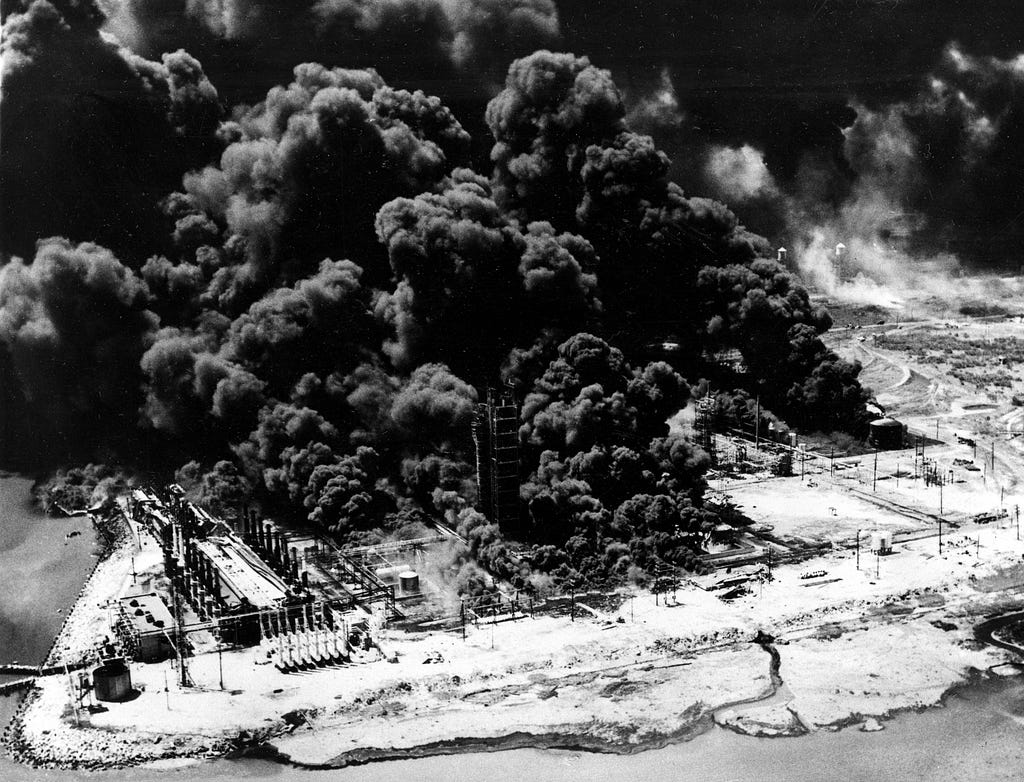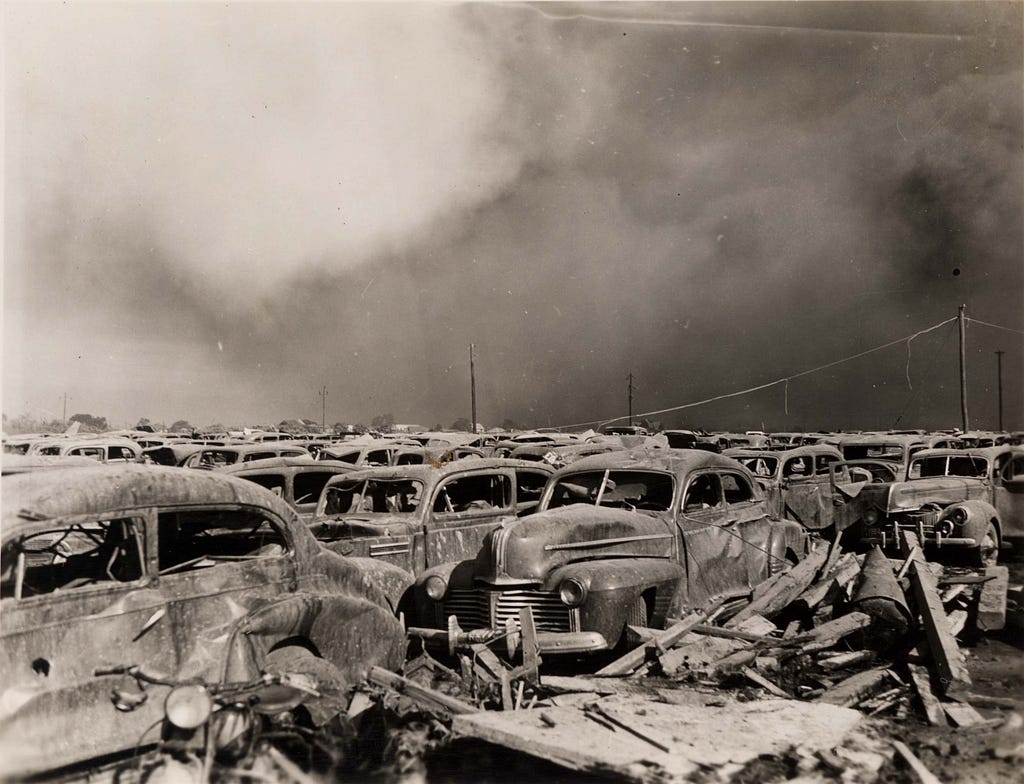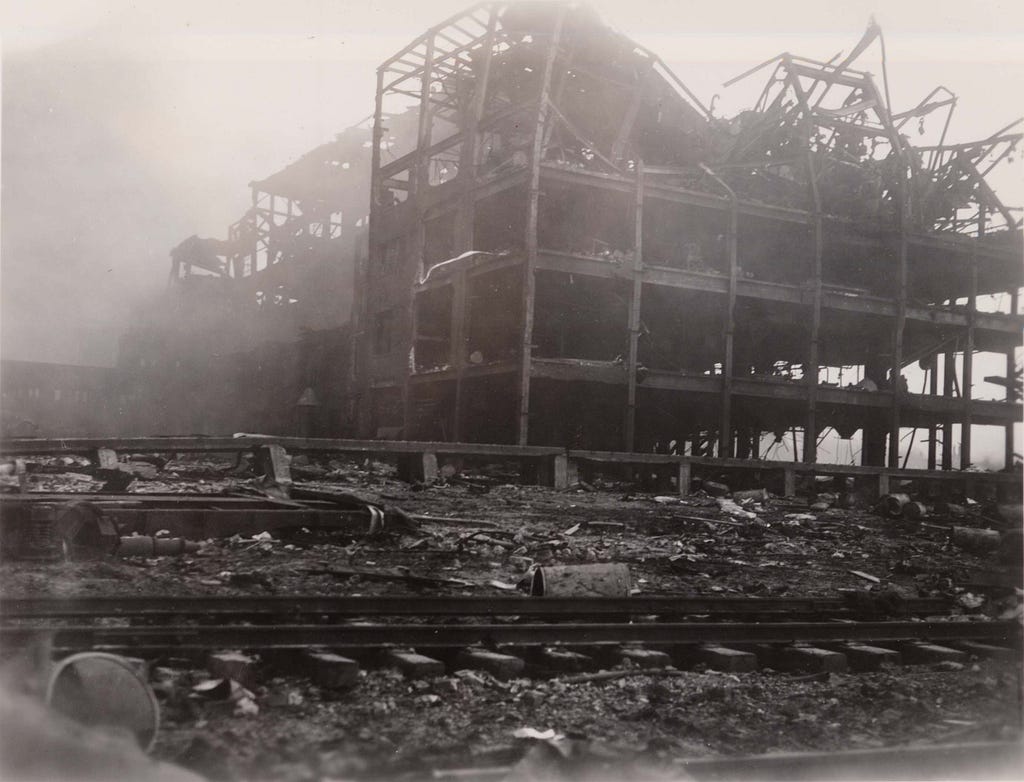The largest non-nuclear explosion in U.S. history destroyed most of a Texas town, killing hundreds
The anchor of a ship landed a mile and a half away

On April 16, 1947, a ship called the Grandcamp docked at Texas City, just north of Galveston on the Gulf Coast. It was scheduled to be loaded with thousands of tons of ammonium nitrate, a fertilizer, to deliver to farms in recovering postwar Europe. The ship had come from Houston, a port that did not allow the loading of the chemical, which in addition to use as a fertilizer, was a powerful explosive and oxidizer. Signs pointed toward the ominous early that morning, as soon as workers noticed that the paper bags of ammonium nitrate they were loading felt warm to the touch.
Workers had already loaded 2,300 tons of ammonium nitrate laced with flammable anti-caking agents like petroleum jelly and paraffin wax when, around 8 a.m., a plume of smoke wafted from the cargo hold. No one knows what caused the fire, but to save the cargo, emergency responders filled the hold with steam, rather than water, to snuff out the supply of oxygen. But the idea went seriously amiss. When ammonium nitrate decomposes, oxygen molecules are liberated. And it’s possible heat from the steam ushered along this process. In any case, there was enough oxygen in the hull to fuel a large explosion.
Spectators gathered around the ship, now producing an odd, yellow-orange smoke. They saw the sea water near the hull begin boiling, while high-reaching waves vaporized upon contact with the ship. Indeed, many of these witnesses proved too close when, at 9:12 a.m., the Grandcamp exploded in the port of Texas City.
In the massive blast, the ship’s steel hull — loaded also with tobacco, sisal twine, and small arms ammunition — was turned to shrapnel. The explosion sent a 15-foot wave over nearby piers and to the shore, killing dockworkers and thrusting an entire oil barge onto land. The Grandcamp’s anchor was blown a mile and a half, and is still preserved as a memorial. The surrounding dock was destroyed, as were 1,000 buildings in the area. Many of them were oil refineries and hazardous materials plants, which caught fire. The resulting conflagration sent a massive cloud of black smoke into the sky. The Monsanto chemical plant across the way was leveled, killing 145 employees inside. Two small sightseeing planes flying in the air at the time were caught in the shockwave and came crashing to earth.
The ensuing chain reaction continued to the following day. A second ship, the SS High Flyer, carrying sulfur and more ammonium nitrate, exploded 15 hours later, killing two more. Oil refineries burned for days after. Destruction poured into nearby residential areas, leaving 2,000 homeless. Some 3,500 people were injured. The death toll was immense, amounting to what is likely the greatest industrial accident in United States history: at least 581 people were killed, including 40 members of the ship’s crew and all but one of the 28-man Texas City volunteer fire department. One real estate broker reflected that the town was not left with enough survivors or skilled labor to “erect one building in a year.”
There was no shortage of witnesses to attest to the astounding power and destruction of the blast. Dr. W.H. Lane, a Monsanto employee, said he “saw scores of bodies as I left my office.” Ben Lapham, a sailor on the adjacent High Flyer, recalled at the the time of the blast that “it was like night for a minute or more. The explosion blew our hatches out and killed several of our men.” Another witness, tossed 20 feet by the blast, recounted his tale to reporters, then immediately fainted.


In the aftermath, firefighters from four cities came to the scene, and later some from as far as Los Angeles joined the days-long effort. Five hundred gas masks were shipped in to aid rescuers as they cut through clouds of smoke and toxic nitrogen dioxide to aid the injured.
There were very practical measures implemented in the wake of the Texas City disaster, including new precautions and better labeling for ammonium nitrate, as well as reforming the port of Texas City to handle petroleum exclusively. But the legacy of the disaster is most pronounced as the subject of the first class-action lawsuit against the United States.
Just a year before the disaster, after some three decades of consideration, Congress passed the Federal Tort Claims Act of 1946, providing citizens the right to recompense for negligence and misdeeds by federal employees. In 1953, the case went before the Supreme Court. A minority opinion in Dalehite v. United States determined that the government had been at fault in how it shipped fertilizer to recovering areas of Europe, that it had been negligent in its manufacturing, shipping, and labeling practices, and failed to warn handlers about the dangers of ammonium nitrate, and did not supervise or enforce safe shipping and storage. “This was a man-made disaster, it was in no sense an ‘Act of God,’” said Justice Robert Houghwout Jackson. “The disaster was caused by forces set in motion by the Government, completely controlled or controllable by it.”
But a minority opinion still meant a loss. The majority of the justices feared a ruling for the plaintiffs would set a fearsome precedent, allowing citizens to obstruct innumerable government processes by claiming harm. Despite the new law, they believed that the government’s policy needs — in this case, ensuring that recovering countries would not get absorbed by the Soviets — prevailed above all, even if citizens did die in the process.
Elizabeth Dalehite, who lost her husband in the disaster, and whose injuries from the explosion left her with small shards of glass in her skin, teamed up with her lawyer Russell Markwell to appeal directly to Congress. With the help of an influential and ambitious Senate minority whip from their state named Lyndon Johnson, Congress eventually sided with the minority opinion of the Supreme Court and passed the Texas Claims Act in 1955. President Eisenhower signed it, though it was rumored he hated the idea of putting blame on the government for a disaster that caused hundreds of millions of dollars in property damage, thousands of injuries, and hundreds of lives.
The Texas Claim Act, after almost a decade of delay and debate, distributed $17 million among 1,394 victims of the disaster. Its more significant implication—that the U.S. government bears responsibility for the harm its negligence deals to its citizens—prevails to this day.
The largest non-nuclear explosion in U.S. history destroyed most of a Texas town, killing hundreds was originally published in Timeline on Medium, where people are continuing the conversation by highlighting and responding to this story.
Powered by WPeMatico


